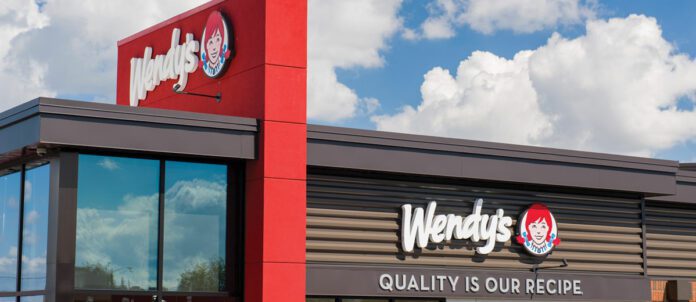In 1969, Dave Thomas opened his first Wendy’s restaurant in Columbus, Ohio. In 1975, the brand brought its signature square beef patties to Hamilton, Ont., marking its first restaurant opening in Canada. Since then, Wendy’s has grown into the third-largest quick-service hamburger company in Canada, with 420 locations in Canada and approximately 7,000 locations worldwide.
“We’ve been in Canada for nearly 50 years,” says Paul Hilder, senior VP and managing director, Canada and U.K., The Wendy’s Company. “Our first restaurant is still operating today. We’ve always been a smaller player, but we’re really focused on quality. We may not be the biggest, but aim to be the best.”
From its highly anticipated breakfast and Wendy’s Rewards launches, to its new Own Your Opportunity franchise-recruitment initiative and Global Next Gen design standard, 2022 was certainly a milestone year for the Wendy’s brand.
“Our breakfast launch has been extremely successful in a very competitive daypart,” says Hilder. “We entered it with a strong foundation of quality and focused on core ingredients and menu offerings that would appeal to Canadian consumers.”
Additionally, the company’s number of restaurant openings in 2022 has propelled franchise momentum into 2023. “[Last year] was probably the highest number of new restaurant openings in many years, and we’ll continue to open more restaurants in 2023,” says Hilder. “We’ve been in franchise-recruitment mode for the last couple of years, and up until the end of 2022, we’ve added well north of 12 new franchisees across the country.”
Launched in April 2022, the Own Your Opportunity recruitment initiative expands restaurant-ownership opportunities and supports the company’s goal of increasing restaurant ownership among under-represented communities. Through this initiative, Wendy’s has created more competitive liquidity and net-worth requirements for all new franchise applicants; continued dialogues with preferred Canadian lenders to expand economic opportunities; supported franchisees through the Build-to-Suit development fund to help fuel growth in under-developed trade areas; introduced new innovative restaurant formats; and conducted franchise surveys, focus-group discussions and business reviews to identify beneficial tools and resources for existing franchisees.
“From an overall business perspective, we have great momentum, which encourages our franchisees to continue expanding our footprint,” says Hilder. “We’ve been building on our strong foundation for the last 10 consecutive years of same-restaurant-sales growth, record AUVs (annual unit volume) and increased foot traffic versus our competition. There’s great opportunity across the country for us.”
Currently, Wendy’s is seeking experienced new single-unit and multi-unit operators who want to help grow the company’s presence worldwide. In Canada, Wendy’s is actively recruiting new franchisees, with significant opportunity in Quebec and the Maritimes. The training fee for new franchisees is $5,000 and the initial franchise fee is $50,000, with a total investment between $50,000 and $2 million. Hilder says restaurants typically range between 1,500 and 3,000 sq. ft. with a drive-thru window.
“We’re very focused on finding new prospective franchisees in Quebec and eastern Canada,” says Hilder. “Wendy’s has been in Quebec for a long time, but we only have 13 restaurants, and we see a lot of opportunity in that market. That’s our next spurt of growth happening now, with new restaurants opening within the next few years.”
Hilder continues, “We’re excited to take advantage of opportunities in smaller towns and communities we traditionally haven’t been to. We’re also seeing a lot of success and opportunity as we open outside of the metropolitan areas across the country.”
The new Global Next Gen design standard includes a delivery pick-up window and delivery parking for drivers; mobile order-pickup parking and shelving in-restaurant; galley-style kitchen, which runs from the front to the back of the restaurant, increases efficiency and oversight for crew across all sales channels; next-generation technology; and optimized infrastructure, such as lighting and HVAC to minimize energy usage and costs. The company is working to debut the first Global Next Gen restaurant builds this year.
“From a real-estate perspective, we took a step back and asked how our customers are accessing the brand today, taking the delivery space into account and how that impacts restaurant design,” says Hilder. “How do you re-design the restaurant to accommodate all these new channels versus the traditional dine in and drive-thru model? This opens the door for non-traditional spaces that are far more customizable.”
The process of finding, recruiting and approving a franchisee can take roughly three to six months depending on individual timelines.
However, Hilder says it can take between 18 and 24 months to officially open a restaurant depending on real-estate timelines. Generally speaking, he says the process involves a prospective franchise questionnaire, market discovery, operational observation (for pre-existing business owners) and a final business plan.
“In 2023, we’re continuing to focus on franchise recruitment to fuel the future,” says Hilder. “The short-term outlook is an additional 50 restaurants, but also continuing to build out. It’s a mixture of new franchisees coming into the organization, but also working with our strong existing franchisees who are well positioned to grow. We pull both levers to drive the business forward.”
When asked to describe the perfect franchisee, Hilder says, “Our franchisees must be passionate about the people who are working for them and serving customers. It starts with the people, followed by customer service, quality and willingness to learn to be a part of the Wendy’s system and model.”
Undoubtedly, Wendy’s has nailed its franchise building strategy for growth and success. By the end of 2025, Wendy’s aims to have between 8,000 and 8,500 operational restaurants worldwide. Hilder says maintaining a strong partnership with franchisees through the ups and downs is key for shared success.
“One of the reasons that we’ve been successful as a franchise organization in Canada is our strong partnerships with our franchisees,” says Hilder. “It’s truly about a win-win-win for the organization, the brand and the franchisee. We’ve built strong partnerships with our franchisees and listened to them, which has been important through the years, especially with the recent challenges we’ve come through in the last few years.”
BY NICOLE DI TOMASSO


















